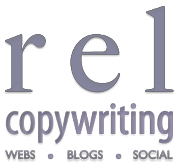Justified Type is classier for online content: Copywriting standards
 Tuesday, February 28, 2012 at 11:24AM |
Tuesday, February 28, 2012 at 11:24AM |  robin ellen lucas |
robin ellen lucas |
 Desktop publishing standards
Desktop publishing standards
Do you use justified type (block justification) for your online content jobs due to its classier look? If so, have you been advised that you need to instead follow the latest web standards, which entail displaying all content left justified?
Of course, words in newspapers, books, magazine articles and ads are justified at the left and the right. Online, when it’s carelessly set, however, this block type can look distorted with extra spaces.
After researching the evolution of online writing, I'm perplexed as to why online writing standards could possibly be below typewritten standards used by the literary world for a long time. I have learned that online writing interfaces were—from the start—easier to program for left justification from a technological standpoint. To this end, they didn't follow the classier standards of the literary world.
Copywriters and web designers today can be rest assured now that modern writing tools are catching up, offering the easily accessible capability to use justified—or full—type. It's not only classier but more visually appealing to the eye. It does take more effort by the copywriter to tweak the justified look so that the text does not look distorted and hard to read at times. Proper justification is, in fact, a tricky technique to master. In spite of that, it’s well worth the effort if high quality, professional-looking typography is your goal.
Why the controversy? Because typographic problems appear if handled poorly, and many experts choose to believe the problems are intrinsic to the typesetting style. If you are aware of the possible problems and avoid them though, you can set beautiful and effective typography.
Paragraphing with unjustified copy can cause visual problems. If the copy being typeset has a number of short blocks containing paragraph indents, the finished piece, if it is set justified, can look as though it was set ragged left and right.
Although unjustified typesetting allows the ability to control word spacing—known to speed up the reading process and allow the reader to absorb thoughts and phrases rather than individual words—and maintain high levels of comprehension, the casual appearance of rag-right composition negatively affects high-quality typography. Truth be known, unless there is excessive white space between words (with justified style), readers don't care, or notice, whether they are reading justified or rag-right columns of text.
Having said that, wouldn't you rather have your content most visually appealing, and expend the effort in doing so? Awkward shapes are not very inviting to the eye, which is inherent in unjustified text, from sentences to paragraphs. Shouldn't copywriting standards adhere to the creation of beautiful and effective copy?
Literary tradition speaks to justified text on the left and the right. The justified format is because it is very predictable, and creates simple geometric shapes that are easy to fit into a design grid. No line-ending decisions need to be made. The area copywriters need to focus on is creation of excessive interword spacing. Short line measures are especially difficult to set flush left and right.
A look at many newspaper columns will show you excessive word space and "rivers" of white running through the copy. Moreover, the longer the line measure the less this problem occurs. Books and magazines that are set justified can have tighter word spacing since they generally use wider columns of type.
There are cases where the block look to justified copy is not visually appealing, such as in the case with poetic works, or advertising brochures, where the shape of the words create a visual effect—lost with a block standard.
As I type this, I am indeed typing within an unjustified user interface, but my website copy with automatically justify when I publish it. I will then do some tweaking of my own.
@ 2012 R.E.L. Copywriting







Reader Comments (5)
Of course, newspapers, books, magazine articles and ads use justified type (block justification). Online, when it’s carelessly set, block type can look distorted with extra spaces. I'm on a project, where the web designer and I are trying convince the client that block style is classier and more visually appealing, but I'm not finding much information out there to back up my--what appears to be modern--stance for online copywriting.
Andy Otes Copywriter (via LinkedIn "copywriters" group)• I don't know that there's anything inherently classier about justified type. It can be quite jarring and gap-toothed unless really well done. The bigest problem with many websites is the use of a font that's too small for the line length. Plus it's usually something appalling like Arial or Airport Anonymous (ie, Helvetica). Also, what's this mania for grey type instead of black or at least charcoal? I guess they just don't want their copy to be read. And it won't be if visitors have to work at it. One click and they're gone.
Hal Werner (via LinkedIn "copywriters" group• I've seen plenty of good justified type in print, but I agree with Andy– it almost never looks good online. Most justified type online looks amateurish. I suspect it's probably a symptom of less advanced typography options for Web.
Thanks, Andy and Hal. I'm intent on setting this copy in Justified type so that it looks decent. I appreciate your comments.... :)
I will keep working on this one and post updates. Glad you found helpful.